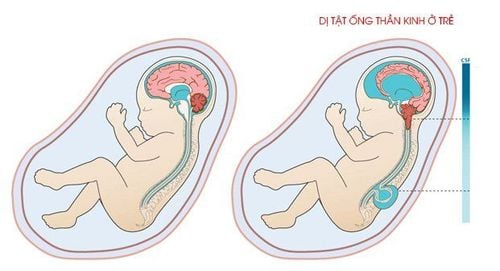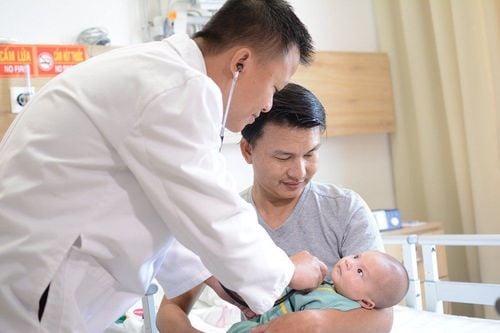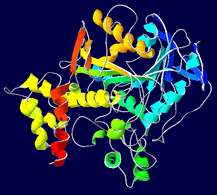This is an automatically translated article.
Spina bifida is a birth defect that occurs in the posterior arch of the vertebrae. Spina bifida deformities cause herniation of components of the neural tube such as the membranes of the spinal cord, the spinal cord, ... So what is the cause of the split vertebrae?
1. What is a split vertebra?
Spina bifida, also known as spina bifida, is one of the birth defects that occurs in part or all of the posterior arch of the vertebrae, possibly in one or more vertebrae.
During the embryonic stage (about 3 to 5 weeks of pregnancy), the development of neural tube closure is abnormal, resulting in bifida malformations. A vertebra has a normal structure consisting of a body, a posterior arch and spines. Abnormality is a condition in which the vertebrae do not have a posterior arch or the posterior arch does not close the neural tube, causing components of the neural tube such as the medulla oblongata, spinal cord, nerve roots, and cerebrospinal fluid to herniate outside the neural tube. terrible. Or other components such as skin tissue, fat tissue, and intestinal tissue fall into the neural tube and stick to the nerve plate.
2. Causes of split vertebrae
The following factors are thought to be associated with spina bifida:
Heredity: Family with a relative with the deformity. Environment: Including factors such as living in a polluted environment, many toxic chemicals, natural disasters, epidemics, wars, ... Pregnancy: During pregnancy, the mother's nutrition is affected. deficiency, especially folic acid, or the mother taking antiepileptic drugs containing valproic acid, vitamin A, or diseases such as diabetes, obesity, ... Gene mutations

Thiếu acid folic là một trong những nguyên nhân đốt sống chẻ đôi
3. What are the types of split vertebrae?
Spina bifida has two main types, which are closed and open. In each category is divided into many different specific cases.
3.1 Open vertebrae malformation
Open vertebrae malformation is a common injury, accounting for about 85-90%. A thin layer of cerebrospinal membrane is covered with or without a membrane, allowing nerve tissue to come into direct contact with the amniotic fluid outside. Open vertebrae malformation includes the following cases:
Meningeal hernia - spinal cord : This is the most common form of malformation in the open body with relatively complex lesions. Cerebrospinal fluid and some components in the neural structure of the spinal cord herniate to the outside of the vertebral canal and are covered by a thin layer of meninges. This hernia protrudes above the surface of the skin. Meningeal hernia: This is a rare open malformation, the thin meningeal covering the hernia contains only cerebrospinal fluid, while the spinal cord and nerve roots remain in the vertebral canal and are uninjured. damage. Spina bifida: This is a severe open vertebral malformation with a flattened disc-shaped mass consisting of nerve tissue but without a sheath, increasing direct contact between the spinal cords. tissue with the external amniotic fluid environment, leading to a high risk of infection for the newborn baby.
3.2 Closed bifida vertebra malformation
Closed-body malformations are rarer, accounting for only about 10-15%. Closed malformations are small lesions, the skin or a thick membrane covering the neural tube, which prevents contact between the nerve structures inside and the amniotic fluid outside. Although it is a rare form, but closed vertebral malformation has a better prognosis than the open type, there have been many children with closed cleft palate without clinical symptoms after birth. . In addition, there are also some children with malformations accompanied by damage to the spinal cord and nerves, making prenatal diagnosis difficult.

Dị tật đốt sống chẻ đôi
4. How is the bifida malformation diagnosed?
4.1 Diagnosis of spina bifida in the prenatal stage
Spina bifida can be diagnosed in the prenatal stage through ultrasound during routine prenatal visits. However, the ultrasound results to determine the type of malformation, in which the closed malformation faces many difficulties. In addition, testing the level of AFP (Alpha Fetoprotein) in the amniotic fluid or maternal blood also indicates the type of malformation.
4.2 Diagnosis of spina bifida in the postpartum period
Spina bifida malformations can appear anywhere on the spine, however, most malformations, including both closed and open types, are vertebrae lesions (with or no retrovertebral arch) and low lumbar-sacral spinal cord attachment. After the baby is born, the doctor will immediately detect the tumor in the lumbar region - the back of the baby, along the lumbar line.
To determine a closed or open malformation, the doctor is based on clinical symptoms, specifically:
Open vertebral malformation: The tumor is an inner cyst containing cerebrospinal fluid. The neural tube can often be seen. If the cyst ruptures over a period of more than 24 hours, the cyst will become symptomatic with a purulent infection and the child may develop symptoms of meningitis. Closed bifida malformation: The tumor is located on or next to the spine, under the skin. If you touch the spine, you will see a few vertebrae that are missing the spinous process and the vertebral plate. On the surface of the skin, there will be abnormal hair, skin pigmentation different from the rest, excess skin and a small pit. In addition, children with vertebral malformations will also have clinical manifestations of a crooked or hunched spine; knee, heel deformation; loss of control in urination (frequent or frequent urination); the lower limbs are weak, have no feeling or reflexes, are paralyzed; leading development.
In addition to the clinical manifestations, some subclinical testing techniques also allow the diagnosis of bifida malformations such as:
Ultrasound: For children under 3 months of age, spinal and transvaginal ultrasound fontanelle. Magnetic resonance imaging (MRI): This is a highly valuable method to help screen for malformations of the central nervous system. X-ray: If the child has a deformity of the knee, heel and spine, an X-ray should be performed. Urodynamics: This technique is used to classify and assess the extent of bladder nerve damage.

Chẩn đoán dị tật đốt sống chẻ đôi dựa vào lâm sàng
5. Treatment and follow-up after treatment of split vertebrae
5.1 Treatment of split vertebrae
For open vertebral malformations, the child needs emergency care for neural tube surgery in the first 24 hours after birth, in order to limit and prevent infection due to the ruptured cyst. For closed cleft vertebrae, the child will be operated on if neurological symptoms appear. If the tumor is dermoid, the child should be urgently operated on to avoid the risk of a secondary abscess; surgical resection of the tumor requires removal of the entire dermis, including the dermoid fistula. If the tumor compresses the spinal cord, surgical removal of the tumor is necessary, however, it should be noted that surgical removal of the entire tumor carries a very high risk of spinal cord injury.
5.2 Monitoring and taking care of children after treatment for vertebrae
After surgical treatment, the child needs to be placed on his or her side or stomach. The child should not be placed on his or her back, as this can cause pressure on the incision. Turn the child around often. Ensure the child's hygiene so that urine or feces do not affect the incision. In about 5-7 days after surgery, the child is catheterized. Monitor and take care of children after treatment for cleft vertebrae to promptly detect and treat complications, if any. Some early complications may occur such as wound infection, CSF leakage at the incision site, meningitis, progression of hydrocephalus. Possible late complications include VP shunt complications, Chiari type 2 malformation, low or empty marrow attachment, bladder nerve problems, lower extremity deformity. Take your child for a follow-up visit every month for the first 6 months, every 3 months for the next 6 months, and every year thereafter. Annual follow-up of the child is measured urodynamics. During the monitoring process, it is necessary to coordinate with the treating doctor and specialist in urology, rehabilitation, orthopedics. Spina bifida is a birth defect that affects the nerves and movement of the extremities, especially the lower extremities. Malformations can be detected and diagnosed during pregnancy as well as after birth. To ensure the health of the fetus, mothers need to prepare knowledge of reproductive health care, periodic antenatal check-ups to receive the best fetal care advice and guidance, and at the same time fully supplement vitamins before pregnancy to avoid birth defects for the fetus.
In order to maximize the prevention of birth defects, women should receive all vaccines before becoming pregnant, and at the same time participate in antenatal classes to gain knowledge before, during and after pregnancy. best at birth.
Vinmec International General Hospital is the address for examination, detection and screening of congenital malformations from the fetus very early thanks to the modern machinery system, a team of qualified and experienced doctors. provide the best treatment to protect the optimal health for both mother and baby.
Please dial HOTLINE for more information or register for an appointment HERE. Download MyVinmec app to make appointments faster and to manage your bookings easily.













